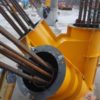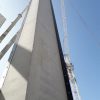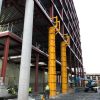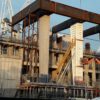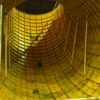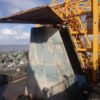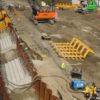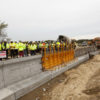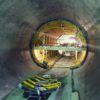What is Steel Formwork
Steel formwork is a type of formwork that is used to shape and support concrete structures during construction. It consists of panels made from steel, which are assembled on site to create the desired shape of the concrete element.
These Panels can either be used to form intricate shapes, walls, bridge piers or columns and many more applications.
What are the benefits of using steel column formwork
One of the primary benefits of steel column formwork is its high level of accuracy and consistency.
Its smooth surface finish and precise dimensions allow for a better fit with other construction materials therefore resulting in a stronger and more durable structure.
Steel column formwork is also extremely durable and can withstand the rigors of construction sites. It is resistant to damage from weather, moisture, and other environmental factors, and can maintain its structural integrity for many years. This makes it a more cost-effective choice compared to plastic and cardboard formwork, which may require frequent repair or replacement.
Breakdown of benefits:
Quality
Steel column formwork provides a high level of accuracy and consistency in the finished concrete columns. Its smooth surface finish and precise dimensions allow for a better fit with other construction materials, resulting in a stronger and more durable structure.
Repeat operations
Steel column formwork can be easily disassembled and reassembled for multiple uses, making it ideal for projects with multiple column pours. This not only saves time and labour costs, but also reduces waste compared to single-use formwork systems.
Sustainability
Steel column formwork is fully recyclable, making it an environmentally friendly choice. Its long lifespan and reuse potential also contribute to its sustainability, as it reduces the need for frequent replacement and disposal.
Transportation and logistics: Steel column formwork is lightweight and easy to transport, making it more efficient to move from one job site to another. It also requires less storage space compared to heavier formwork systems.
Durability
Steel column formwork is extremely durable and can withstand the rigors of construction sites. It is resistant to damage from weather, moisture, and other environmental factors, and can maintain its structural integrity for many years. In contrast, plastic and cardboard formwork may become damaged or weakened over time, requiring frequent repair or replacement. Timber formwork, while also durable, is prone to warping and splitting, which can affect the accuracy and quality of the finished concrete columns.
Fire resistance
Steel column formwork is non-combustible and has a high melting point, making it resistant to fire. This is an important safety consideration on construction sites, where the risk of fire is always present. Plastic and cardboard formwork, on the other hand, are flammable and can contribute to the spread of fire in the event of an accident. Timber formwork, while also combustible, has a lower melting point than steel and is more prone to fire damage.
Ease of use
Steel column formwork is easy to handle and assemble, thanks to its lightweight and modular design. Its smooth surface and precise dimensions also make it easier to achieve a smooth and uniform finish on the concrete columns. Plastic and cardboard formwork can be more difficult to work with, as they may have rough or uneven surfaces and may require additional bracing to maintain their shape. Timber formwork can also be cumbersome to handle and may require additional time and labor to assemble.
Conclusion
Overall, steel column formwork offers numerous benefits over plastic, cardboard, and timber alternatives. Its superior quality, repeatability, sustainability, and logistical advantages make it a top choice for construction professionals looking to achieve high-quality, consistent concrete columns.
Steel circular column formwork is typically more durable and long-lasting than cardboard alternatives. It can be used multiple times and is less likely to become damaged or deformed during the concrete pouring process. Additionally, Steel is also more resistant to water and other elements, making it a better choice for outdoor construction projects.
In terms of carbon footprint, steel is typically heavier and requires more energy to produce and transport than cardboard, which is made from a renewable resource and can be easily recycled. However, steel column formwork is reusable and can offset the carbon footprint over time.
Ultimately, the choice of formwork will depend on the specific needs of the project, including budget, project duration, and the size and complexity of the column being formed

